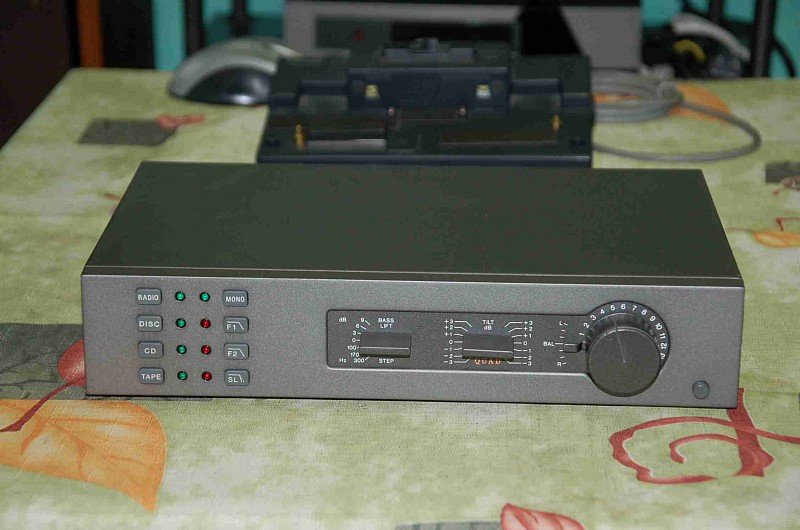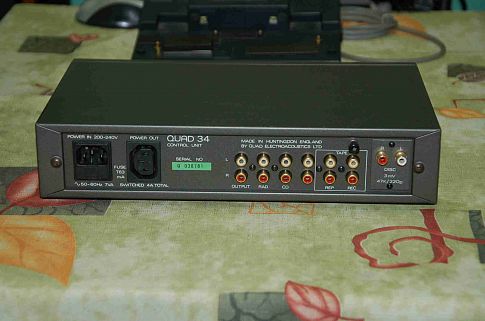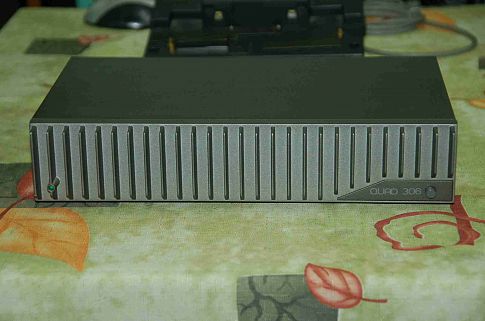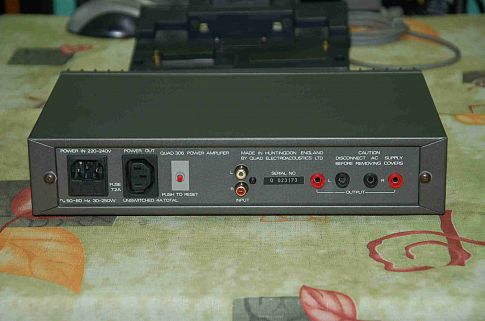



QUAD – единственный производитель аудиотехники в мире удостоенный “Queen’s Award for Technological Achievement”.
Комплект: усилитель предварительный QUAD 34 и усилитель мощности QUAD 306 из Великобритании. Прекрасный звук за скромные деньги. Состояние нового, вплоть до оригинальной упаковки.
Произведен апгрейд – заменены электролиты на новые той же марки на фирме “Dada Electronics Europe”.
Цена 20000 руб.
В случае продажи по отдельности цены по $400.
Продается дешевле цены на www.ebay.co.uk .
Разумный торг возможен.
Quad 34 Pre Specification
Line Source Frequency Response : 20 Hz – 20 kHz (+/- 0.3 db)
Disc RIAA Frequency Response : 20 Hz – 20 kHz (+/- 0.5 db)
Distortion:
Quad 34 preamplifier
This solid-state design is supplied with a built-in moving-magnet cartridge preamplifier, and a moving-coil preamp is included with it for (easy) installation by the user if desired. (Remove two screws, pull out the old module, plug in the new one and replace the screws. The job takes about 3 minutes.) The MC preamp supplied is for 20 microvolt-output cartridgescontrary to the instruction booklet’s statement that the supplied one is the 100µV version. Modules having a rated input level of 100 or 400µV are available as extra-cost options.
The 34 has sensitivity characteristics complementary to those of the 405 power amplifier. With a rated output of 500mV, it will be unable to drive most US and Japanese power amps to full output, and this time there is no simple solution comparable to the one referred to in my review of the 405 amplifier, other than to use it only with a European power amplifier such as the Quad 405. Its phono inputs are RCA sockets, but all other connections to and from the preamplifier are via DIN receptacles. Adaptors are provided for the Tape connections and one high-level input, but additional sources will require additional adaptors (which most audio dealers carrying Quad, Creek, or B&O components should have in stock).
The Aux input, incidentally, can be used as either an input or an output (by inserting internal circuit-board jumpers and using a 4-conductor Tape adaptor cable), but not simultaneously. Since the inputs and outputs are common to one another and not the two sides of an interruptible loop, they can be used either to feed input signal to a second recorder or to listen to its playback, but attempts to do both at once will connect the recorder’s outputs to its inputs and may cause a destructive feedback condition.
The 34 has three pushbuttons on it for selection of HF filtering. Two of them provide 6dB/octave attenuation, with 3dB points of 10kHz and 7kHz, respectively. (They cannot be depressed simultaneously.) The third switch increases the sharpness at which the first two roll-off the high end. The effect of these is not subtle, but neither is their efficacy in eliminating crud and distortion.
Also unsubtle are the actions of the bass and tilt controls, which are incremented in 2dB steps. The bass Lift (boost) acts like a Baxandall control, with the turnover frequency moving upwards as the boost is increased. The bass Step function is unusual in that, instead of rolling off the low end (thus progressively attenuating the deeper bass), this one depresses the entire bass range by about 6dB relative to the upper ranges, introducing a shelf into the low-end response. The amount of shelving remains constant, but the control varies the frequency at which the shelf cuts in (100, 170 or 200Hz). This varies the low-end balance without affecting its low-end limit.
The Tilt control, which as far as I know is unique to Quad’s preamps, does exactly what its name implies: it rotates most of the audio-range frequency response around an 800Hz axis, so as to change the overall balance of the sound from warm to cool without affecting either the apparent volume or the "color" of the sound. (Fig.1 shows Quad’s curves for this control, fig.2 shows the measured effects for this cpomtrol and for the filters and phono stage.) Each increment changes the 100Hz level by 1dB in the direction opposite to the 10kHz level, providing a 2dB bass/treble change.
Because of the ear’s tendency to latch on to the average signal level over a wide range as the "normal" level, the subjective effect of this control is actually rather different from what is shown in the curves. The frequency extremes, although actually "flat" in terms of the horizontal, sound as though they curved in a direction opposite to the middle-range tilt. Thus, the curve showing a 3dB rise at 100Hz and below sounds as if the low end rolled off below about 50Hz and the high end tipped up above 12kHz. This is advantageous, because it allows a significant amount of adjustment of the overall balance of a recording without undue detriment to its frequency extremes.
What all this adds up to is a preamp/control unit far better able than most to correct for many of the worst and most commonly encountered sonic flaws in recordings. The "lack of subtlety" in the action of the controls is no liability whatsoever when the problems they are correcting for are so gross.
Sound quality
Aha, but what does the 34 sound like? And there’s the rub. It is colored. Not seriously, but significantly. The much-overused term "velvet fog" is appropriate here, for this is a rather forgiving preamplifier, tending more to errors of omission than commission. Inner detail is not very good, its low end is a trifle woolly and does not shake the floor (even when it should), and its high end seems to round off the burrs and sharp edges of the music much as did the early Dynaco tubed preamplifiers. It does not , however, share with those tubed units their edgy brightness. The sound is, if anything, too suave and rich, always eminently listenable but never palpably real.
As an isolated component, I find this just too chocolatey-sweet for my taste. But it does mate well with the rest of Quad’s system, the ESL-63 speakers and the 405 power amplifier.
Incidentally, Quad’s instruction booklet for the 34 preamplifier makes a very good point about listening level, asserting that for a given recording there is only one correct volume setting. I agree generally, but with qualifications. The "correct" setting is where the perceived volume of the instruments "agrees" with their apparent distance from the listener, which makes perfect sense when the recording was done with "purist" microphone techniquetwo, or at most three, microphones for pickup of the entire group.
But many multimiked recordings produce an ambiguous perspective, where instruments sound very close yet far awayLondon is is a master of this so-called near-far soundand for these the "correct" volume setting is far less ordained. In either case, propoer volume adjustment requires a certain familiarity with the sound of the real thing, which is something audiophiles as a group cannot always bring to a listening session. Some recordings, such as the ones Harry James has done on Sheffield Lab, demand very high playback levels in order to sound realistic; for these kinds of recordings the Quad ESL-63 speakers are simply not appropriate.
Many audiophiles like to play all recordings at very high level, sometimes because the loudspeakers are "slow" and seem to prevent the sound from escaping from them, sometimes simply out of a wild and crazy desire to feel the music. And hard-rock enthusiasts are notorious for playing their systems at ear-shattering levels for no better reason than "Because" (footnote 1). The Quad ESL-63s are not designed for that kind of abuse, and although they may not be damaged by it (unless continued for some time), they just won’t deliver that much SPL. They are designed primarily for the classical-music listener who intends to listen at volumes one would encounter in a typical (perhaps even distant) concert hall seat. J. Gordon Holt
Footnote 1: JGH himself is not totally immune to this temptation. Larry Archibald
Quad 34 Preamplifier
Made in England (1982-1996)
© 2011 KenRockwell.com. All rights reserved.
The Quad 34 Preamplifier. enlarge.
Rear, Quad 34 Preamplifier. (about $350 used). enlarge. This free website’s biggest source of support is when you use these links, especially this link directly to the Quad 34 Preamplifier at eBay (see How to Win at eBay), when you get anything, regardless of the country in which you live. Thanks! Ken.
Optimized for astoundingly accurate symphonic music reproduction in concert with the very finest loudspeakers, the Quad 34’s exceptional TILT control allows the listener to choose his own seat in the hall. The unique TILT control also allows one to compensate precisely for overly bright or dull recordings. Want a little more warmth, or a little more detail? The TILT control delivers this without colouring the sound.
The stereo volume control tracks within an astounding tenth of a dB, ensuring that the stereo image never shifts as the volume is changed.
The BASS LIFT control does the best job I’ve ever heard at low-level loudness compensation in 40 years. It also compensates well for smaller loudspeakers, acting as an electronic subwoofer, boosting only the very lowest bass without altering the mid- and upper-bass. The BASS STEP control removes bass boom or bloat caused by placing loudspeakers too close to the wall in a small home. The smooth HF filters eliminate high-frequency zing or distortion.
Very compact, and therefore ideal for today’s desktop audio use.
For use in the USA, it may require a licensed technician to alter it for use on 120 VAC.
The output levels are optimized for Quad’s own power amplifiers, like the matched Quad 306. For use with ordinary American power amplifiers, it will require a licensed technician to alter it for use with larger audio output voltage levels. Be sure to see my warnings under Usage.
Introduction top

I use Adorama, Amazon, eBay, Ritz, Calumet , J&R and ScanCafe. I can’t vouch for ads below.
This popular (at least in the UK) and compact (only 12½" or 32cm wide) Quad 34 preamp is optimized for the enjoyment of symphonic music through the world’s finest loudspeakers, namely the QUAD ESL-63 electrostatic in its day, or today, Harbeth.
The Quad 34 preamp excels in having the world’s most useful tone controls which allow a listener to choose his favourite seat in the hall, regardless of where the recording’s producer thought he should sit.
The Quad 34’s most astounding innovation is its TILT control. The TILT control is an eight-pole filter which allows subtle optimization of the relative brightness or warmth of the music’s original performance space to your listening room, without adding any colouration. Unlike conventional tone controls, its effects are very subtle — and therefore very powerful.
Selecting inputs and filters is easy: just tap the electronic buttons on the left. The signals are switched electronically, with no relays or distortion-inducing mechanical switches needed.
Of course all music sounds great through this preamp; when I mention symphonic music that’s because live acoustic performances are the most difficult to reproduce, and it is for these performances that the Quad 34 is designed.
This Quad 34 replaced the earlier Quad 33 in 1982.
The first versions of this Quad 34 had an AUX input and had 5-pin DIN connectors for most inputs and outputs.
The newest versions of this Quad 34, as seen here, used RCA connectors and relabeled the AUX input as CD.
Most Quad 34 came with an extra interchangeable moving-coil (MC) DISC input module. Different modules allowed for different pickup loading.
About 40,000 were sold across 14 years. It was gone from catalogues by late 1996.
The TILT control is this preamp’s claim to fame. Serious music lovers are at the symphony every week, unless they’re performing and rehearsing daily, and know that there is no such thing as one unique "sound of a live performance."
These musical people are intimately and regularly familiar with actual live performances, and know that every seat sounds different. Some listeners prefer the front rows, others the middle rows, while others prefer the rear of the hall. Every seat presents a different perspective. The TILT control allows one to optimize the reproduced perspective to suit one’s taste if the recording’s producers and engineers had a different opinion.
For instance, while London and Decca’s UK recordings tend to be neutral, Deutsche Grammophon’s tended to be forward, and USA’s Telarc tend to be more distant. With the TILT control, you can put yourself where you want to be.
The TILT control also allows subtle correction of other equipment, cables, connectors, power cords, Shatki stones, recordings, speakers and acoustics that are slightly too bright or analytical, or that are too dull and reserved.
The TILT control really works. No, its action is not as obvious as old-fashioned bass and treble controls, and therein lies its power. It corrects subtle variations in perspective, equipment, cabling or anything in the signal chain and can restore perfect balance to reproduced music. Remember, Quad make the world’s finest loudspeaker, the ESLs, and this preamplifier is designed to extract the most musical enjoyment out of them for serious music listeners, even if audio hobbyists are chasing other things.
As Quad says, "The results obtained from any programme source depend on the aggregate effect of the listening room and the recording environment together with the corrections applied by the recording engineer, and the equipment of the reproducing chain."
The real kicker is where Quad adds "…it is extremely unlikely that the arbitrary combination of these variables when listening at home will will yield the closest approach to the original sound," and therein lies the need for this subtle control.
The TILT control can improve the subjective quality of musical reproduction, while adding no colouration, just a simply slight increase or decrease in overall warmth or brightness.
Likewise, the BASS LIFT control is brilliant. It really makes a world of difference with small speakers, boosting only the missing low bass like an electronic subwoofer, and adding back in low bass missing at low playback levels.
The BASS STEP control drops low bass response by precisely 5.5 dB to correct for boomy rooms or bloated recordings. The 100 Hz, 170 Hz and 300 Hz positions merely change the transition frequency, not the ultimate reduction.
The smooth-rolloff HF filters eliminate high-frequency zing, tizz or distortion. Unlike most high filters, these are brilliantly slow in rolloff so that they don’t add honk or artifacts related to a sharp cutoff.
As critical as any or all of the above is a volume control which keeps the channels precisely balanced at every level. The Quad 34 is extraordinary as having the most tightly-specified tracking of any preamp at 0.5 dB, and it exceeds this by a factor of about five. Most preamps are so sloppy that they deliberately don’t specify channel tracking. At low levels, most preamps are fifty times worse than this Quad 34.
The inputs switch instantly, so if they are active with signal, there can be very mild clicks.
The Quad 34 is non-inverting, meaning that the polarity of your source is never changed.
The Quad 34 Preamplifier. enlarge.
It’s painted in two tones of semi-metallic brown that looks much better in person than it does in my illustrations.
It looks great paired with wood, and of course we all have our own preferences. I love its simple, pure, and to-the-point design.
It feels great: a light tap is all it takes to select an input or filter.
The input LEDs are your pilot light. They make it easy to see how it’s set from a distance.
The tone and volume controls are double-premium Alps precision stepped attenuators. They feel perfect. The volume control knob is the perfect diameter and depth, and the pot has just the right detents and damping. By comparison, the Apt Holman Preamp’s volume control pot and knob has too much damping and is too thin.
Just like professional mastering equipment, every setting (except Balance) is detented and numbered for easy logging and recall.
Be careful not to bang the BASS and TILT control knobs; the shafts are thin for aesthetics.
The volume control tracks incredibly well, however with only 21 steps and 57 dB of maximum attenuation, lacks the lower-level positions of other preamps like the Apt Holman Preamp, with its 31 steps and 66 dB range.
Just like 1940s broadcast console knobs, I feel that the engraved index on the volume control ought to be filled with white paint.
The little Balance control lever is weird and a little hard to move precisely, but it does its job. Aesthetically, it vanishes, as befits a rarely used control.
There is no headphone jack because music reproduction of the quality which is expected by the Quad user isn’t available thorough ordinary 1/4" or 3.5mm-plug dynamic headphones. It is expected that this preamp will be used only with electrostatic headphones, like the Stax, which are fed from their own dedicated power amplifiers connected to the OUTPUT or unmarked spare TAPE REC outputs.
There’s no need for a MUTE control; when the volume is set to zero, the output is completely muted at 98 dB below maximum gain.
The case is heavy-gauge sheet metal, with felt pads on the inside top and bottom to dampen vibration.
The preamplifier slides out of the case after removing two rear screws.
The knobs are all metal, except for the power button on the lower right, which is a plastic shaft that reaches back to the internal power switch.
The front plate is painted cast aluminum.
The circuit boards are dual-layer with plated through-holes. ICs are soldered directly without sockets.
Amplification is with discrete transistors at low levels, and plenty of TL071 and TL072 FET op amps. These FET op amps have extremely high input impedances, just like tubes, and therefore allow realization of very precise active filters. These FET op amps help maintain a warm, tube-like sound compared to traditional bipolar-input op amps, for those who care.
Signal selection is via 4066 CMOS switches, with Motorola MC14066BCP and Philips ICs.
The Volume Control is designed into the feedback loop of an operational amplifier so it varies the actual gain of that stage, with the appropriate benefits to noise and distortion.
The Quad 34 offers many weird gain options for inputs and outputs.
Sadly, the Quad 34 always runs the rest of its internal circuits at full gain, and reduces gains for inputs or outputs as needed with resistive pads, not by eliminating gain stages or reducing actual amplifier gain.
The Quad 34 only consumes 2¾ Watts of power as measured, so it runs cool and ought to last a long time.
The amplifier supply rails only run +8.6 and -9.6 volts, not the more common ±15 V, so the active devices ought to last several lifetimes.
It has a switched power outlet on the back.
Since Quad redesigned the circuitry many times over the years, you’ll see different rated specifications.
All voltages are RMS.
Input Selector and Filters, Quad 34 Preamplifier. enlarge.
Rated 100 mV, 5 V maximum. 100 kΩ load.
DISC (phono cartridge)
Usually rated 3 mV (150 mV maximum), 47 k Ω, 220 pF. Other values often programmable.
Moving coil module rated 100 µV (5 mV maximum), 100 Ω, 22 nF. Sometimes rated 200 µV (10 mV max.), 100 Ω, 22 nF, and variable.
CD (a.k.a. AUX on earlier models)
AUX rated 100 mV (5V Maximum), 100 k Ω.
CD usually rated 300 mV, variable with plug-in resistors.
Marked REP under TAPE, for Tape Reproduce (professional parlance) or Tape Replay (hobby parlance).
Rated 300mV (15 V maximum), 120 k Ω. Often adjustable with plug-in resistors.
Gain, Polarity and Volume Control top
Interchannel balance rated as ± 0.5 dB over the entire range of the volume control, the tightest specification I’ve ever seen. Most preamps aren’t good enough even to list this specification.
The main output to the power amplifier is labeled OUTPUT.
Rated 0.5 V, 830 Ω source impedance.
The earliest samples were rated 1.5 V.
The output to a tape recorder is marked REC under TAPE.
Rated 100 mV, 2.2 k Ω source impedance. Altered with plug-in resistors.
RADIO, CD or TAPE at OUTPUT or TAPE REC: ± 0.3 dB.
DISC RIAA Frequency Response: ± 0.5 dB.
Frequency range was listed as 30 – 20,000 Hz, and then 20-20,000 Hz as of 1989.
0.05%, worst-case, any input, 30-10,000 Hz.
First rated as an unqualified 0.005%.
-105 dB, A-weighted, Volume Control at minimum.
That sounds impressive, unless you realize that this is a meaningless specification!
Turning off the volume control means even the noisiest preamp ought to be quiet, and worse, the dB rating is made without any reference, making it a meaningless, undefined number. Whoops!
The signal-to-noise ratios were rated as follows, relative to rated inputs, with inputs loaded:
